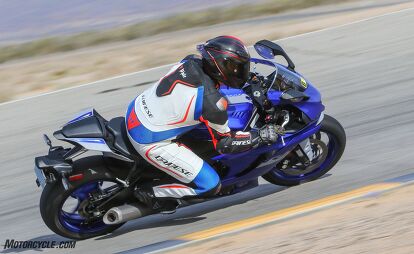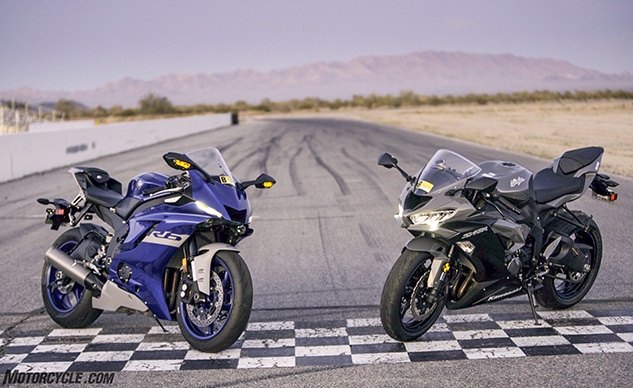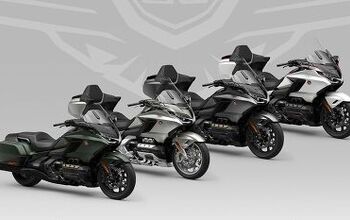A Novice Track Rider's Perspective

Kawasaki ZX-6R vs. Yamaha YZF-R6
Don’t you ever get tired of reading track comparisons from guys that are riding at international race-winning levels? From guys who have been racing their entire lives and who drag elbow like it’s their job (literally)? Me neither, but the guys here at MO and I thought there might be someone out there who could appreciate insight from what a novice track rider might experience when comparing some of the latest 600-class supersports. The two most recently updated of which happen to be the Yamaha R6 and Kawasaki ZX-6R.
Get the Flash Player to see this player.
Becoming more proficient around a racetrack is one of my goals moving forward, both personally and professionally. Longtime MO readers may have noticed I’ve done a couple of track schools in the past few years – the last of which being Yamaha Champions Riding School – during my time at the website, but I’ve never been able to bolster that learning with enough seat time to truly focus on improving my skills (balancing off-road riding and track days on my own time is difficult). Well, it just so happened we had the Kawasaki ZX-6R sitting in the fleet from our time with the now-defunct Cali Track Days and more recently from our trip to the Inde Motorsports Ranch with YCRS , a Yamaha R6. It was then that I thought to myself, “How could I add to my ever-overflowing workload?” Then it dawned on me, “Let’s do a comparison!” It was Troy’s idea for me to fly this one solo. He doesn’t like hanging out with me.
So, What’s New
What’s new with these two bikes anyway? Not exactly a whole lot. Both bikes are built on foundations that had existed for numerous years prior, but when you have a proven well-built platform in a market that isn’t exactly keen for new sportbikes, can you really blame them?
Of these two, the Yamaha R6 received a more thorough update in 2017 which saw a new R1-derived KYB fork, an electronics package including six levels of traction control (as well as off), ABS (that’s always on), three ride modes, a new Nissin front master cylinder, weight saving measures throughout, and new aesthetics bringing it more inline with the R1 and R1M superbikes.
Kawasaki’s ZX-6R didn’t receive quite as many updates in 2019 . The upgrades consisted of new bodywork, a quickshifter, one tooth smaller front sprocket, adjustable clutch lever, and a new instrument panel with fuel gauge and range display. The biggest news though, was what the ZX-6R lost, and that was about $1,700 dollars off its MSRP. Coming in at $9,999 for the base non-ABS model, the 2019 Kawasaki 636 made itself a much more enticing option to riders looking for a middleweight sportbike. ABS adds $1,000 to the Kawi, which still sees the ZX-6R ringing up for a full $1,200 dollars less than the 2020 R6.
Measuring Spec Sheets
Both bikes are powered by Inline Fours but the Kawasaki’s larger 636cc displacement gives it a bit of an advantage when it comes to performance numbers. Yamaha claims 116.7 hp at 14,500 and 45.5 lb-ft of torque at 10,500 rpm. According to Kawi, the Ninja is putting out its 128.2 hp 1,000 revs lower at 13,500 and reaching its 52.2 lb ft of torque at 11,000. The Kawasaki motor delivers a bit more mid-range grunt, and with the smaller sprocket up front, it’s easy to let the Kawi roll down into its rev-range before launching it out of corners on the throttle. While the Yamaha may not have the mid-range of the Kawasaki, that engine is a screamer. The R6 may only rev 500 rpm higher at redline, but its happy place is way up in its rpm range where it pulls hard once it hits the powerband, while the Ninja is a bit smoother with gradual power delivery throughout.
But, what goes fast must slow down, right? The Yamaha’s dual 320mm discs are ground to a halt by two four-pot calipers and a new-for-2017 Nissin master cylinder providing hydraulic feedback at the lever. It was interesting grabbing the front brake on both of these bikes back-to-back. The Yamaha’s lever is quite stiff with very little freeplay. When braking, the initial bite I had hoped for wasn’t there, but stick with it and the power comes on plenty strong.
On the Kawasaki, its 310mm discs are also slowed by four-piston calipers, but feel at the lever is completely different. There’s more freeplay before getting into the stopping power, and that power was easier to modulate and dial in, making me feel more confident with the Kawi’s front brake. It’s not all gravy for the ZX-6R’s binders though. At a separate track day after spinning as many laps as I could, I got in too hot into a tight corner and experienced a dash of brake fade at the most inopportune moment. Thankfully, I was able to keep it on track with the rubber side down, but it definitely spooked me.
Both the R6 and the ZX-6R’s suspensions are fully-adjustable front and rear. Team Green is using a 41mm inverted Showa SFF-BP fork with top-out springs, stepless compression and rebound damping, and adjustable spring preload with 4.7 inches travel. The Kawi’s rear uses a bottom-link Uni-Trak gas-charged shock with stepless compression adjustment as well as rebound and preload adjustment with 5.9 inches of travel.
The Yamaha R6 borrows its 43mm KYB fork from the R1 (with valving and spring rates better suited for the R6). Fully-adjustable, the R6’s fork’s preload, rebound, and compression damping is adjusted at the top of the fork tubes. The KYB piggyback shock offers preload, rebound, high-speed compression, and low-speed compression adjustment. Both ends have 4.7 inches of travel. The Yamaha is decidedly stiffer out of the box while the Kawasaki provides a more plush ride that is nicely planted as long as the rider is smooth with his or her inputs.
On Track
When it comes to riding these two, both bikes feel as the spec sheet would allude. Yamaha says its R6 weighs 419 lbs while Kawasaki claims the ZX-6R tips the scales at 430 lbs. The Yamaha also has a shorter wheelbase, steeper rake, and shorter trail. As those specs might suggest, the Yamaha feels a touch more nimble, although that comes at the cost of stability. The ZX-6R feels slower to turn in and heavier when being tossed from side to side, but it also felt more stable and probably added to my feeling comfortable on the Kawi much more quickly than the R6. I’ve ridden the R6 on a few different occasions and always came away impressed by its handling. It was only after riding these two, one after another, for five sessions in a day that those nuances became apparent.
Kind of sticking with the theme that’s developing, the R6 also has a much more aggressive riding position. A rider looking for a single bike to pull track duty and day-to-day riding may be happier on the Kawasaki. The seat is also nearly an inch lower on the Ninja. Tank size is nearly identical at 4.5 for the ZX-6R and 4.6-gallons for the R6.
There are other factors to feeling comfortable at the track aside from the bikes themselves, of course. Having tires that you can count on to heat up quickly and maintain grip throughout the day while offering excellent rider feedback are just as important as a well-fitting set of leathers or helmet. Having one less thing to worry about helps you focus on the task at hand. The Metzeler Racetec RR K1 tires were fantastic throughout the day and still had plenty of life left in them when we were done. Every time I open the garage door, I can’t help but think I’d like to find another track day to work into my schedule to take advantage of the life left in the Racetec RRs on both bikes.
Thanks again to Two Wheel Track Days for having us out and giving us some special concessions to get the content and time we needed with these two bikes. If you find yourself near Chuckwalla Valley Raceway, Willow Springs Raceway, or Las Vegas Motor Speedway, look those guys up.
At the end of our day, my opinions about both bikes were still split. After having time to digest my thoughts a bit more, there are two ways one could view these bikes. The Kawasaki ZX-6R seemed easier to get along with from the get go; it’s more comfortable, delivers usable power, and has a lower MSRP, making it easier to jump on and ride. That being said, one would be hard-pressed to try to recreate the Yamaha R6’s lightweight maneuverability.
I’ve learned that racers typically look at bikes differently. They consider what they like about a bike that can’t be changed and worry about fueling, suspension, and any other things that can be tweaked later. I think if you plan to get serious about track days or to start racing, maybe the Yamaha is the better platform for you to work with. If you’re planning to just do track days one or two times a month and maybe use the bike on the street too, the Kawasaki ZX-6R could be the better option. Again, the money saved gives you a nice little nest egg to start modifying the Kawasaki as you see fit.
In Gear

- Helmet: AGV Pista GP-R $1,400
- Suit: Dainese Misano 2 D-Air $2,500
- Gloves: Dainese Full Metal 6 $430
Boots: Dainese Axial D1 $530
2020 Kawasaki Ninja ZX-6R | 2020 Yamaha YZF-R6 | |
|---|---|---|
| MSRP | $9,999 $10,999 with ABS | $12,199 |
| Engine Type | Four-stroke liquid-cooled DOHC inline 4-cylinder; 16 valves | Four-stroke liquid-cooled DOHC inline 4-cylinder; 16 titanium valves |
| Displacement | 636cc | 599cc |
| Bore x Stroke | 67.0 x 45.1mm | 67.0mm x 42.5mm |
| Compression Ratio | 12.9:1 | 13.1:1 |
| Maximum Power | 94.1 hp at 13,500 rpm (claimed, European model) | 85.9 hp at 14,500 rpm (claimed, European model) |
| Maximum Torque | 52.1 lb-ft. at 11,500 rpm (claimed) | 45.5 lb-ft. at 11,500 rpm (claimed, European model) |
| Fuel System | DFI with 38mm Keihin throttle bodies (4) and oval sub-throttles | Fuel injection with YCC-T and YCC-I |
| Ignition | TCBI with digital advance | TCI: Transistor Controlled Ignition |
| Transmission | 6-speed, return shift | 6-speed; multiplate slipper clutch |
| Final Drive | Sealed chain | Chain |
| Electronic Rider Aids | Kawasaki Traction Control (KTRC), Power Mode, Kawasaki Intelligent anti-lock Brake System (KIBS), Kawasaki Quick Shifter (KQS) (upshift only) | YCC-T ride-by-wire throttle, adjustable traction control, three selectable ride modes |
| Front Suspension | 41mm inverted Showa SFF-BP fork with top-out springs, stepless compression and rebound damping, adjustable spring preload; 4.7 inches travel | 43mm KYB inverted fork, 3-way adjustable; 4.7 inches of travel |
| Rear Suspension | Bottom-link Uni-Trak with gas-charged shock, stepless compression damping adjustment, 25-way adjustable rebound damping, fully adjustable spring preload; 5.9 inches travel | KYB piggyback shock, 4-way adjustable; 4.7 inches of travel |
| Front Brakes | Dual 310mm petal discs with dual radial-mounted, Nissin 4-piston, monobloc calipers and KIBS ABS (optional) | Dual 320mm hydraulic disc; ABS |
| Rear Brakes | Single 210mm petal discs with single-piston caliper and KIBS ABS (optional) | 220mm hydraulic disc; ABS |
| Front Tire | 120/70 ZR17 | 120/70 ZR17 |
| Rear Tire | 180/55 ZR17 | 180/55 ZR17 |
| Frame Type | Tubular, diamond frame | Deltabox aluminum frame |
| Rake/Trail | 24.5°/4.0 inches | 24.0°/3.8 inches |
| Length | 79.7 inches | 80.3 inches |
| Width | 28.0 in | 27.4 inches |
| Height | 43.3 inches | 45.3 inches |
| Ground Clearance | 5.1 inches | 5.1 inches |
| Seat Height | 32.7 inches | 33.5 inches |
| Wheelbase | 55.1 inches | 54.1 inches |
| Fuel Capacity | 4.5 gallons | 4.6 gallons |
| Curb Weight | 430 pounds (claimed) | 419 pounds (claimed) |
| Color Choices | Candy Steel Furnace Orange/Metallic Flat Spark Black, Metallic Spark Black/Metallic Flat Spark Black | Team Yamaha Blue, Vivid Orange/Matte Raven Black, Raven |

Ryan’s time in the motorcycle industry has revolved around sales and marketing prior to landing a gig at Motorcycle.com. An avid motorcyclist, interested in all shapes, sizes, and colors of motorized two-wheeled vehicles, Ryan brings a young, passionate enthusiasm to the digital pages of MO.
More by Ryan Adams

























































Comments
Join the conversation
the 2,000 dollar difference in price should be factored in, you can do a lot to the Kawasaki with that money.
I'm actually looking to replace my R6 track bike for a ZX-6R for all the reasons mentioned. The R6 handles really well but man, it's torture to ride. Way too uncomfortable.